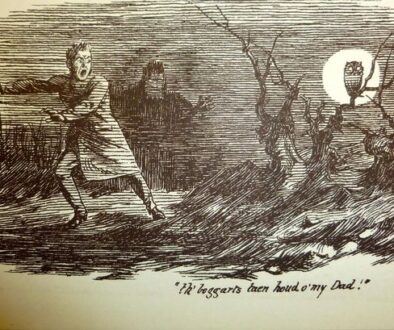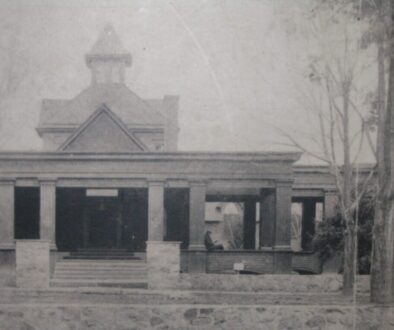The Hill of Dead Witches
To some extent we English speakers are raised on Aristotelian – Greek – thinking. Our whole conceptual system is based on absolutes and zero-sum games. (“Indeed, you have persuaded me, Socrates, that if a thing is of this quality it cannot also be of that…”)
For the Native Americans it was different, and the Western mindset can find it hard to get a handle on many Native concepts that aren’t so mutually exclusive. For the Native Americans a path or trackway can be used for simple travel, for commerce, and even for the course of war parties, and still be considered utterly sacred and just as vision-worthy as if it had no other use.
The Native American mindset suits what I perceive of the paranormal better. To me one of the interesting traits of the field is the way reports and stories of all paranormal types often cluster together in small areas. It can take years for a pattern to fall into place. You hear one set of reports, then more… Then you realize there’s a pattern, not of just one kind of paranormal/supernatural thing – like, say, ghosts, or UFOs – but of all of them.
One of Western New York’s major hotspots is a zone centered around a hill in Allegany State Park. What the white guys used to call Bay State Hill overlooks a bit of flat space by a river, “Witches’ Walk,” with its own story, and were the two not separated by a drive into the Park and the I-86 expressway you’d think of them as the same tract. To the Seneca, though, this is Ga’hai (GUH-high) – “Witch-Light” – Hill, a region of magic and mystery where anything otherworldly is likely. It’s an “X-Zone,” in other words, whose intrigue affects many who come here. This wooded hill has reports of a number of what I call “weirdosities.”
The northern Alleganies are just part of a region that has long been a major zone for UFO reports. This hill has to be considered within it. I’ve heard a number of alleged UFO sightings within this area. I haven’t heard about any touchdowns or Third-Kind encounters. I have heard reports about the MIBs (“men in black”) in the general region.
As for mystery-monsters, the place seems to be a paranormal zoo based on the combination of folklore and reports. The legendary spookies include Bigfoot, a giant mystery cat, a giant white bear, a giant white buck, and even some humanoid amphibian like the creature from the Black Lagoon. (Lest that last item sound even more ridiculous than it does, no less a paranormal author than Loren Coleman chose to list the blastie in one of his books.)
As you would figure, some of the characters of classic Iroquoian tradition like the Stone Giants and the Great Snake of the Allegany appear in the lore of the region. High Hat, the cannibalistic giant, may be more of a local bogie and exclusive to the Seneca tradition.
Ga’Hai Hill and the region nearby may be also a realm of ancient mystery. Strange stonework has been found in the region. What appeared to some to be a “slaughter-stone” was a large flat-topped rock with apparent runnels at its edges that reminded some observers of blood-draining grooves and sacrificial rites that would have been virtually unheard-of in the Northeast Woodlands. Harvard’s Barry Fell (author of America, BC) thought he found evidence of many pre-Columbian migrants from other parts of the world. He interpreted one marked, etched stone to be the memorial of a European Celtic King named “Zari.” One thing that is incontestable is an apparent stone fort atop a neighboring hill called “Old Baldy.” If the formation was built by Native Americans, it was built by a group of them that preceded the Seneca, who were not, as we presume, fort-builders. While the subject of mysterious ruins is not supernatural or paranormal in itself, those sites tend to become magnets for supernatural legends.
Another Iroquoian tradition that tends to startle the uninitiated is that concerning the Little People. These legendary figures are basically the Longhouse version of the European fairies. The matter is probably so little-known outside the reservations because it is so protected. Whereas the Europeans, even those who believed in the fairies, felt free to tell stories about them and even analyze them in the presence of folklorists, most of the Longhouse/Hodenosonee people, the Iroquoians, will not talk about these traditions to outsiders to their culture. Nevertheless, we hear through back-channels that this one hill – Ga’Hai/Bay State Hill – has become a focus of the local Little People mythology. The apprehension many Salamanca residents hold for this hill is said to be due to the fact that it is regarded as a sacred zone to the Little People, at least at certain times of year. Some Seneca hold these supernatural Little People in great reverence, and the matter for them is one of respect. Others, though, seem to dread them and avoid this hill like it held a failing nuclear reactor.
I haven’t heard reports of human-style ghosts on Ga’Hai Hill but they would be only too logical there, and they are frequently reported in nearby sections of Allegany State Park. Some ghosts seen on the trails of the park look to witnesses like old settlers, which would be logical since there were many 19th century communities in the voluminous park. At other times they come in the forms of hunters, hikers, and runners.
I have heard of apparitions – spontaneous visual phenomena – of other types that make this particular hill an occasional nightmare for hunters and campers. If any of them do make it through the night on Ga’Hai Hill, some of them report curiosities like crazy sound effects and bizarre animal-images like deer walking upright on their hind legs.
The ga’hai – the “Witch Lights” – of Iroquois folklore are reported of this hill, of course; that is its name. I’ve written about these luminous, nocturnal, volleyball-size ga’hai many times. They are presumed in the folklore to be either the markers, the guide-beacons, or even the astral presences of witches.
People in Salamanca will tell you that the Witch Lights can be spotted on that hill at night from far away. I hear that some locals go on watches for them the way other people go sight-hunting UFOs or whales. Witch Lights would be classified as apparitions, of course, since nobody can ever seem to catch one and prove its physical reality. Witch Lights are very different from the orbs of pop ghost-photography since they appear to the naked eye and not just in retrospect through photography. Things like these Iroquois Witch Lights appear in tradition all over the world. These lights would be classified as Anomalous Light Phenomena – ALP – in the terms of British researcher Paul Devereux, and they are commonly associated with sites that are rich in other types of paranormal legend: battlefields, ruined castles, ancient monuments, and the occasional haunted house.
To complicate matters, the area is not far at all from the site of the Kinzua Dam and reservoir on the Allegany River. While the Dam’s 1960s construction may have spared places downriver like, oh, Pittsburgh, from disastrous floods, the appropriation of the land sent shock waves through the Seneca psyche. (For reasons that might be imagined with little difficulty, Native Americans tend to be highly suspicious of any U. S. government usurpation of their land or sovereignty.) Many of the Senecas’ more recent sacred sites like Cornplanter’s grave and Handsome Lake’s vision-site are now underwater. Imagine a proposal to turn Arlington, Mecca, or Bethlehem into a lake. The event and the long legal struggle that preceded it was a time of psychic disruption in the whole region. Many outdoor apparitions were reported during this period, some of them huge and ominous, and many of them on or near Witch Light Hill.
According to my late friend the Salamanca storyteller DuWayne “Duce” Bowen, the Seneca always believed that this region was a prehistoric battlefield, so the ancient curiosities and the contemporary apparitions may point to something real. In the logic, the psychic energy of all these deaths made it a fertile ground for magic. It was thought to be so haunted that only wizards and witches dared walk here after dark, hence the name “Witches’ Walk.” Even today no Seneca wants to break down while driving by here at night, even on the busy I-86 that cuts right by it.
There may be even more to Ga’Hai Hill. In 2005 I led a ghost walk of Saratoga Springs that ended up in a conversation with one of the attendees, a mature woman with an old family tradition to tell me about. She was a member of the Onondaga Nation of the Iroquoian Confederacy. According to her, one of her grandmothers – way back – had fled to the Allegany region of New York State (then Seneca country) to escape the witch-persecutions going on in Onondaga territory. (The center of gravity of the Onondaga Nation was today’s Syracuse, NY. The Onondaga are considered the Keepers of the Council Fire and the oldest of the Iroquois Nations.) The timing of this event, I figure, could have been the early 1700s or even earlier.
More intrigue was to come. Eventually her many-times-great-grandmother got into hot water in Seneca country, too, and over witchcraft. Maybe word from the Onondaga had followed her westward and people were on guard. Maybe she really was a witch and the Seneca got it right on their own. She could have been executed over it. She might well have had a normal life, too, though people remembered her reputation when it came time for her burial. She was laid on the hill in question, Ga’Hai, with all the other suspected witches, including the ones who really were killed for the practice.
Though no parts of this story can be proved, its components hold together. There was said to have been a massive cycle of accusations and executions going on in Onondaga territory in the late 17th or early 18th centuries. Most of it was over by the time the whites arrived, and it was remembered only in the oral tradition of the Iroquois Nations.
And the Seneca often did reserve special places for the burials of their witches. There was good reason: because the bones and bodies were considered emanators of the orenda, “the Force,” they had accumulated in life. Even after death it was believed that the powers of exceptional individuals – great warriors, healers, chiefs, clan mothers, or witches – could continue to influence the living who came near their burial places.
This meant, of course, that the graves of great witches were almost radioactive, being able to spread their otkon – the evil side of the Force – to those who unwittingly came near and possibly even inspire a wave of new witches. (The Star Wars motif of the light and dark Force could be almost directly lifted from the Iroquoian system.) No wonder you didn’t want witches resting near the muggle dead. No wonder you wanted to know where they did lie so no one would go near them unawares. And no wonder people would see Witch Lights on that hill today.




